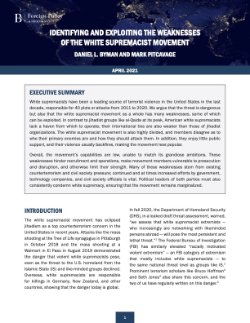Identifying and exploiting the weaknesses of the white supremacist movement
Daniel L. Byman and Mark Pitcavage
White supremacists have been a leading source of terrorist violence in the United States in the last decade, responsible for 40 plots or attacks from 2011 to 2020. We argue that the threat is dangerous but also that the white supremacist movement as a whole has many weaknesses, some of which can be exploited. In contrast to jihadist groups like al-Qaida at its peak, American white supremacists lack a haven from which to operate; their international ties are also weaker than those of jihadist organizations. The white supremacist movement is also highly divided, and members disagree as to who their primary enemies are and how they should attack them. In addition, they enjoy little public support, and their violence usually backfires, making the movement less popular.
Overall, the movement’s capabilities are low, unable to match its grandiose ambitions. These weaknesses hinder recruitment and operations, make movement members vulnerable to prosecution and disruption, and otherwise limit their strength. Many of these weaknesses stem from existing counterterrorism and civil society pressure; continued and at times increased efforts by government, technology companies, and civil society officials is vital. Political leaders of both parties must also consistently condemn white supremacy, ensuring that the movement remains marginalized.
Washington, Dc:Brookings Institution,2021. 12P.


